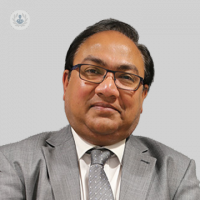How common are fibroids and how do I know if I have them?
Written by:Fibroids are relatively common, particularly in women between the ages of 30 and 50. However, not all fibroids cause symptoms, and not all fibroids require treatment. Leading gynaecologist Mr Kausik Das explains the symptoms that fibroids can cause, why they occur, and when treatment is necessary.

What are fibroids?
Fibroids are growths that develop in and around the womb. They are non-cancerous and are made up of muscle cells and the fibrous tissue. They develop from the walls of the womb, otherwise known as the uterus. This is the organ where the baby grows during pregnancy.
The wall of the womb is made up of quite a thick muscle layer, and from this muscle layer growths can appear, which are known as fibroids. They are supplied by blood vessels and are hormonally dependent.
Fibroids most commonly affect women between the ages of 30 and 50. After menopause, however, they stop growing, and sometimes shrink.
How would I know if I had fibroids?
Not all fibroids cause problems – some are benign. Fibroids causing problems depends on how big they are, but most importantly, on where they are located within the uterus. They can actually grow within the muscle layer, they can grow outside the muscle, or sometimes they can grow within the cavity. If they continue to grow within the muscle layer or if they grow outside of it, they can become larger in size.
Fibroids which grow within the muscle layer or outside of it can cause pressure symptoms as they press on other organs. For example, if they grow on the front wall of the uterus, they can exert pressure on the bladder, which means you need to go to the toilet more frequently. They can also cause the sensation of heaviness lower down.
On the contrary, if fibroids grow within the muscle cavity, they can cause all sorts of problems with your monthly period, such as irregularities, heavy period flow, and painful periods.
Visit your GP if you experience the sensation of heaviness described, or if you can feel a lump in the lower part of your tummy, or if you are having heavy/irregular periods. Your GP may organise an ultrasound scan to check for fibroids.
How common are fibroids?
Fibroids are very common, and around 1/3 of women will experience some sort of fibroid. Most women will be completely unaware of their existence, and not all fibroids cause problems – in fact, again only 1/3 of those with fibroids will experience problems. Fibroids most commonly affect those of Afro-Caribbean descent, those who are slightly overweight or obese, and those who do not have children.
What is the treatment for fibroids?
The treatment for fibroids will depend on the symptoms you are experiencing, and the position or size of the fibroid itself. Treatment also depends on your individual needs, and whether you have had children or not – and if you wish to in the future. This is taken into consideration as the main treatment for fibroids is surgery.
If you have had children and do not wish to have more, and the fibroids are multiple and large in size, hysterectomy is the main option.
If the patient wishes to keep the option of future children open, and wish to try for a baby or more children, the fibroids must be removed. If the fibroids are growing within the cavity, the fibroids can be removed by a special instrument with a camera attached (laparoscopy), but if the fibroids are growing outside the cavity, a major surgery called a myomectomy is generally performed.
However, new techniques for the removal of fibroids are being developed. One of these techniques is called uterine artery embolization, and it is carried out by a radiologist. In this procedure, microscopic PVC glue or string is used to block the blood supply to the fibroid from the uterine artery.
New techniques using high-frequency ultrasound and laser ablation are also being developed, but for the time being, these are highly specialised areas.
If you are experiencing fibroids and symptoms related to fibroids, seek advice from your doctor and get a referral for specialist care, so you can plan the management of your fibroids together.


